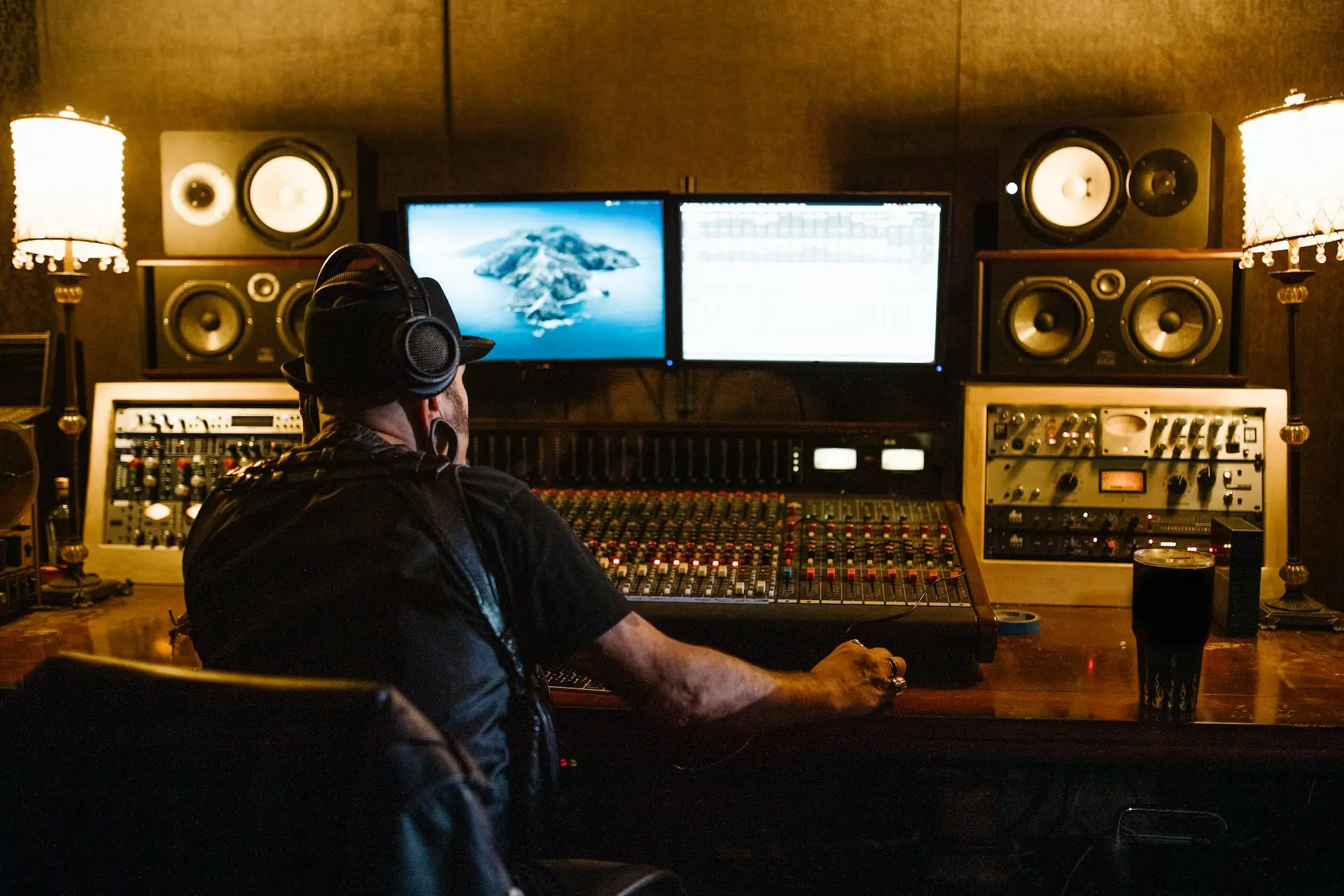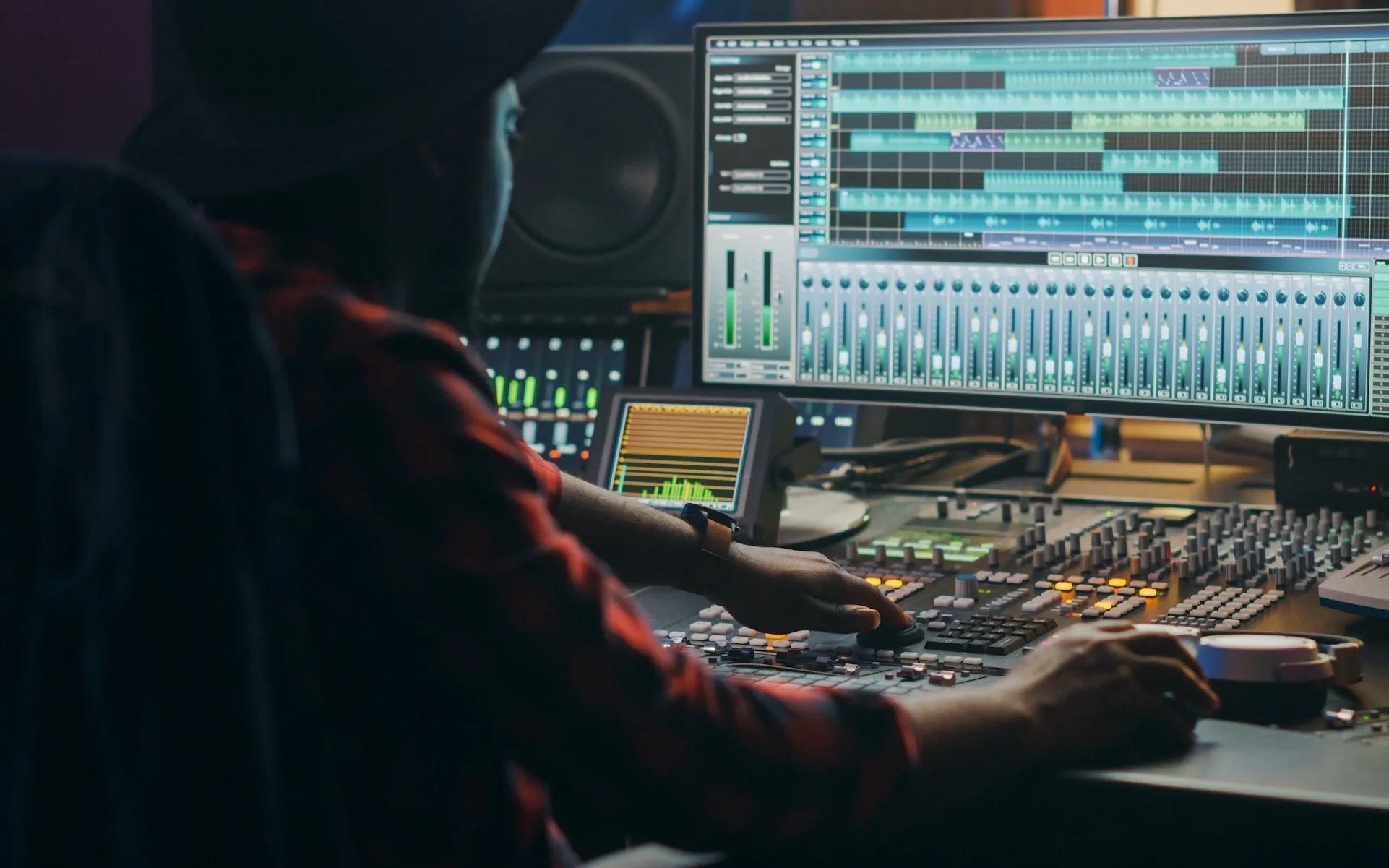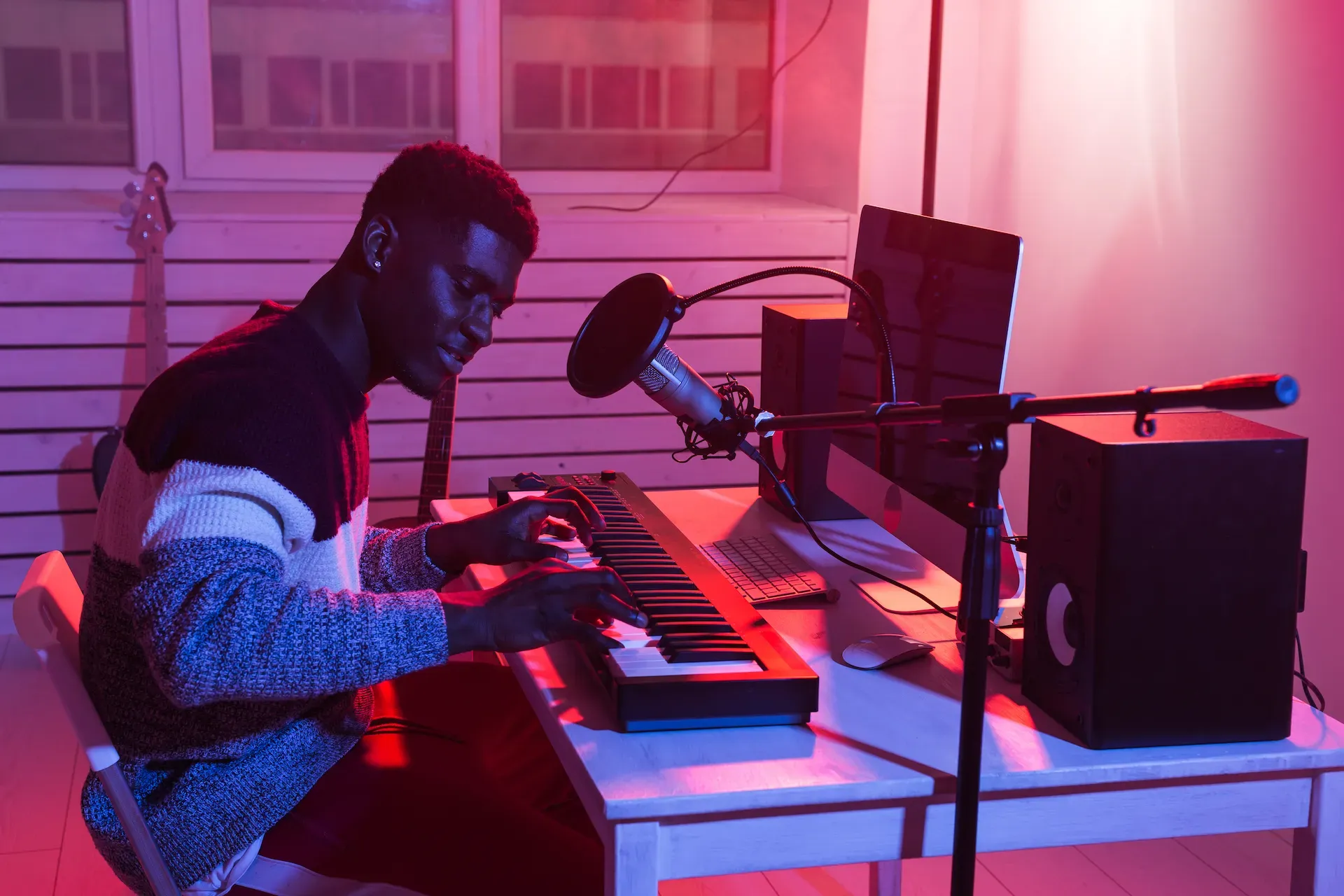25 sound design tips and tricks you should start using today
Sound design helps immerse audiences in your content. Learn the 25 tips, tricks, and techniques that'll improve your sound design.

Sound design takes movies, TV shows, video games, music, and more to the next level — it creates a world that's fully realized and believable.
But what are the core sound design tips, tricks, and sure-fire techniques you should know? Let's look at 25 fundamental dos and don'ts in this sound design 101.
We'll cover:
- Know your gear
- Organize your plugins
- Record everything, delete nothing
- …but don't be afraid to remove effects
- Save effect chains
- Get inventive with your EQ
- Use noise
- Presets are your friend
- Try the Haas Effect
- Use distortion
- Build up layers
- Add transient sounds
- Try time-stretching
- Don't overuse bass
- Use vocoder on non-vocal sounds
- Reverse your work
- Try convolution
- Employ sidechaining
- Enjoy the silence
- Don't be afraid of inspiration
- Try panning
- Use patch cloning
- Auxiliary send and return tracks
- Learn to play an instrument
- Pace yourself and plan sessions

Our top 25 sound design tips and tricks
Whether you're a freelancer or a full-timer at a creative studio, it can't hurt to brush up on sound design. So, start up your digital audio workstation, strap your headphones on, and get busy reading our top 25 sound design tips and tricks.
1. Know your gear
We're starting with the most obvious point, and hopefully it doesn't sound like we're teaching you to suck eggs: read the manual, read it again, and read it a third time for the heck of it. Research your gear. Test it before you use it for a commissioned project. Do anything and everything you can to prepare before using your software and hardware — once you know the rules, you'll have the freedom to break them.
2. Organize your plugins
It's tempting to drag and drop plugins like you're picking apples from a tree, but the order in which they're placed impacts the following effect. For example, a compression plugin will sound different depending on what comes before and afterward.
Plan the order of your plugins, or if you've time to spare, throw them onto the project timeline and start playing around. As long as you understand how each plugin affects the others around it, you should be fine.

3. Record everything, delete nothing
Blend your own sounds with preset effects from a catalog. Record a voiceover and pile on the wackiest filters you can think of. Mix to your heart's content and don't be worried about making mistakes, except for that massive, flashing, bright red one: don't delete your work.
Regardless of whether you've spent ten minutes or ten hours working on something, there'll be something salvageable there. Label everything correctly, save it in an appropriate location, and keep it for a rainy day. Mistakes are valuable, and you might even be able to repackage some old, previously unworkable pieces later down the line.
4. …but don't be afraid to remove effects
Sometimes, less is more. Sound design can get messy, and there's such a thing as one effect too many. If your sounds and textures have congealed into something resembling a sonic soup, there's no harm in taking things away — stripping everything back can help you see where you went wrong and how to fix it.

5. Save effect chains
Once you've nailed a sound, remember to save the effect chain you created to get there. Even if you rarely use the sound in question, it's handy to have it available at the click of a button. Not only is this a massive time-saver, it'll help you build your own catalog of custom sound design tricks.
6. Get inventive with your EQ
Your editing software's EQ settings are there to be experimented with — no need to be shy! Different frequencies will alter the final product, so get stuck in there and start twiddling some knobs.
7. Use noise
You'll be used to smoothing over white noise and dead air, but there's room for it to be used in your favor. Pair noise with high-pass filters to create off-kilter whizzes, squeaks, and other effects.

8. Presets are your friend
Sometimes, you can't perfect your sound design manually. There's no shame in that, and you might be able to solve your problems with a good ol' preset. Then, once you've gotten going, you can adjust said preset to blend in with the rest of your sound design.
9. Try the Haas Effect
The Haas Effect pans two identical mono tracks to the far left and far right of a stereo track, playing one at a tiny delay — between 10ms and 30ms — behind the other. This 'tricks' viewers' ears into hearing the two tracks as one, resulting in a thicker sound. The Haas Effect is perfect for mixing additional elements into your sound design palette without muddying it up.

10. Use distortion
Don't be afraid to ramp up the saturation or overdrive — try out different levels and see what happens when you rough up certain sounds. If you want to go the whole hog, you can even try bitcrushing segments, creating some high-frequency chaos you can't achieve with regular EQ.
11. Build up layers
If you're looking to sculpt a unique sound, you can always layer several effects on top of each other. For example, there's no 'real' sound for extraterrestrial beasts, and it'd sound strange if you just used something like a pig sample. Resample, rerecord, rinse, and repeat until you've got something you're happy with.
Need sound effects for your project? Don't sweat it. Check out our catalog of more than 90,000 sound effects below.

12. Add transient sounds
If some of your sounds need a bit more bite, try layering the transient of a harsher sound — a thud on a table, a kick drum, a thwack against a punching bag — into a sampler, then play it on top of the sound you want to roughen up.
13. Try time-stretching
You've probably used time-stretching to match a sound against on-screen action, but what if you took it further? What if you stretched a transient sound to the point where it becomes something completely different — a thunderclap morphed into a groaning dragon?

14. Don't overuse bass
Bass is addictive — it lends your sound design a full, rich weightiness which you might not have achieved originally. Be careful, though. Too much bass can make your mix seem repetitive and overbearing.
15. Use vocoder on non-vocal sounds
Sure, vocoders are designed for vocals. But who's to say you can't apply them to different sounds — what about a laser going 'pkew,' a gust of wind, a car's rattling suspension, or something else entirely? Think outside the box and see what works.
16. Reverse your work
Reversing sounds isn't exclusively for subliminal messages on old heavy metal records. Rather, it's a simple technique that can quite literally flip your audio around — tease out new cadences and see if a flipped track can create something new.
Reversing drumbeats gives a snare hit fresh purpose, while reversed reverb can be used to transition or 'lead in' another sound. If you want to hear what elite-tier reversed reverb sounds like, check out the intro to Depeche Mode's Personal Jesus.
17. Try convolution
Convolution is a technique that applies the sonic traits of one track to another — it can make for some unique, thought-provoking results. It's often paired with reverb, but you can throw it onto other effects and tracks, too.
18. Employ sidechaining
Sidechains are the chef's kiss on any sound design project with a ton of ingredients. In a nutshell, it focuses on one effect, setting it as a 'rule' to trigger another effect whenever a certain audio level is reached. You've probably heard it used by radio DJs and pretty much every EDM artist around.
While sidechaining is often associated with compression on kick and snare hits, that's not the only thing it's good for. Take Logic's ES2 synth, which lets you sidechain filters and other effects — it's like your own little audio butler.

19. Enjoy the silence
Even Michael Bay movies are quiet sometimes. Albeit, not very often, but the point stands: not every second of your mix needs to be packed with effects and noise. Think about how to use silence to build suspense or underline a certain effect, musical sting, or line of dialogue.
Not every track has to cut in and out — they can fall to a pin-drop volume, morph into something else, judder and hang on a certain note, pulse across your mix every few moments. Silence can be just as powerful as its counterpoint!
20. Don't be afraid of inspiration
You can spend hours rifling through thousands of presets and plugins, and still come up short. If you're struggling to find exactly what you want, don't be afraid to go back to the well for inspiration — search for similar sounds across TV, film, and other mediums. You'll be surprised by how many lightbulb moments come from your 97th Game Of Thrones rewatch.

21. Try panning
Panning is excruciating. It takes ages. It can often be dull work. But is it worth doing? Absolutely. Any high-budget production worth its salt will use panning — it's what separates the pros from the rest.
Panning audio embeds the audience in the world of your content, making it feel real. Yep, it's tedious to organize, but once you've nailed it in the mix, panning will give your sound design that unmistakable, professional sheen.
22. Use patch cloning
If you want to get a feel for a new plugin, try patch cloning. Open the plugin in two instances, initializing one while loading a preferred preset into the other. From there, slowly match all the parameters of the first plugin with the second, patched one.
As you do this, you should note how each change affects the patch, and by how much. This is a slow process of trial and error, but it'll give you a well-rounded view of your patches' parameters.

23. Auxiliary send and return tracks
Auxiliary sends and returns create audio paths separate from the central mix, allowing you to route them to external processing devices. Here, you can EQ and process the specific sounds, lending them a well-rounded, 3D quality.
Afterward, you'd send the processed audio back to the main mix, giving you more control over individual aspects of your sound design.
24. Learn to play an instrument
You don't have to play like Prince or write like Mozart, but a little musical theory goes a long way. Understanding chord structures, scales, and the potential of specific instruments will help you unlock new sounds. You can still be a great sound designer without this, but the more you know, the more doors you can open.

25. Pace yourself and plan sessions
Some people can multitask. Others can't. Whichever method floats your boat, we'd recommend dedicating chunks of time exclusively to sound design sessions. Set up slots to achieve certain goals or try new things — play around with a new preset, solve a problem that's been bugging you all week — and make sound design a constant, diarized part of your schedule.
After all, it can be a grueling, time-consuming process. If you're hopping in and out of sound design on top of other studio or on-site responsibilities, it can be hard to find focus time. Set goals, hit them, then move on to your other responsibilities.
So, with those 25 sound design tips, tricks, and techniques in mind, it's time to apply that knowledge to your next project.

And if you need a varied, high-quality catalog of sound effects to support your work, we've got you covered. Whether you're working as a freelancer or part of a wider creative team, you'll find what you need with Epidemic Sound: more than 90,000 sound effects and 40,000 tracks, to be exact.
Our catalog is high-quality, affordable, and safe. An Epidemic Sound subscription goes beyond royalty-free music, removing the headache of licensing and freeing you up to do what you do best. You can enjoy the safety of our license hand-in-hand with our massive catalog of 40,000 tracks, covering just about every genre you can think of. You’ll also gain unlimited access to our advanced search functions — finding the right sound’s never been easier.
It’s better than royalty-free. It’s worry-free. Get started with Epidemic Sound below.

Related posts:

